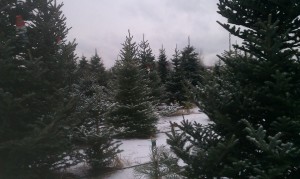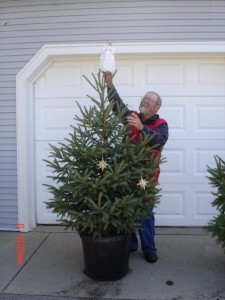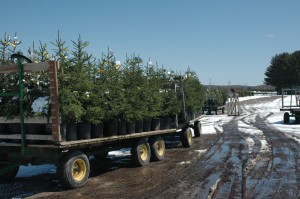One of my ‘other duties as assigned’ this time of year involves serving as The Christmas tree Guy and responding to various media inquiries about Christmas trees. Last week I posted a link to a media story about Christmas trees on the Garden Professor Facebook page. That post drew a response from Kyle Fletcher Baker who derided cut Christmas trees as “murder of the innocent.” My initial reaction was, “Jeez, Kyle we’re talking about fir trees here not lamb chops or veal.” But Kyle’s post serves as a reminder that there are many people that object to cutting trees for Christmas decoration – no word on how these folks feel about cut flower arrangements but that’s another story. In some cases this objection stems from the belief that Christmas trees are cut from native stands of trees. In fact, virtually all Christmas trees sold at tree lots are grown on tree farms for that expressed purpose.
There is also a sizable portion of the population that believe artificial trees are more environmentally responsible than using a live tree. My personal opinion is this is a fairly small factor in most people’s tree buying decisions but the question persists and seems to get a lot of media play. The American Christmas Tree Association (a trade group that represents artificial tree retailers NOT tree growers) commissioned a life cycle analysis (LCA), which estimated cradle-to-grave carbon footprints for real and fake trees. The bottom-line of the study is that the impact of both is negligible. The tipping point is how far you drive to get a real tree each year and how long you keep your artificial tree. If you get your real tree close to home or combine getting your real tree with other trips, the carbon footprint of the real tree comes out better.
But if the thought of cutting a real tree is still more than your conscience can bear, there is a third option: a living Christmas tree. Many nurseries and Christmas tree farms offer container-grown or balled-and-burlapped trees that can be planted outdoors after the holidays. There are even companies springing up on the west that specialize in live Christmas tree rentals. These companies bring a tree into your house and then pick it back up after the holiday. Some will offer a certificate that the tree will be planted in a park or national forest after its display.




You should mention that Christmas trees produce a lot of oxygen and remove carbon dioxide year round since they are evergreens. They are also renewable and can be recycled for other purposes while artificial trees are made of plastic (petroleum) and eventually end up in a landfill.
Live Cristmas tree vs fake tree..hmmm…
The artifical tree is made from plastic/metal. We all know plastic is made from oil. The carbon foot print for drilling,processing,and manufacturing oil into plastic is huge,
I have many friends who love those living Christmas trees and happily plant them in their yards after decoration. But here in the northeast, it seems crazy to take a live tree into a livingroom for a month and then expect it to survive the winter when you put it back out. Are there any stats on survival rates for those trees? I have cautioned people against them, thinking that they just make people feel good but don’t actually survive planting.
Hi Rebecca:
We’ve done some research on this, as has Dr. Rick Bates at Penn State. Success with transplanting living Christmas trees can range from 100% to 0%. There are two main factors that come into play. First is how long the tree is displayed indoors. When trees are brought indoors, they begin to lose cold hardiness almost immediately; so the longer trees are indoors, the more likely they will suffer cold damage when you bring them back outside. The second factor is how the tree is stored between being in the house and planting outdoors. We recommend watering the tree thoroughly and storing in a protected, unheated space such as screened-in porch or unheated garage and planting in spring. I have seen recommendations to dig a hole before the ground freezes and then plant right after the holidays. The only way this makes sense is if you dig the hole big enough for the entire tree and just make it a grave.